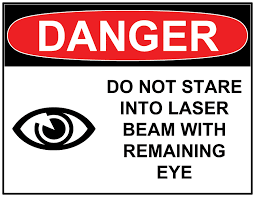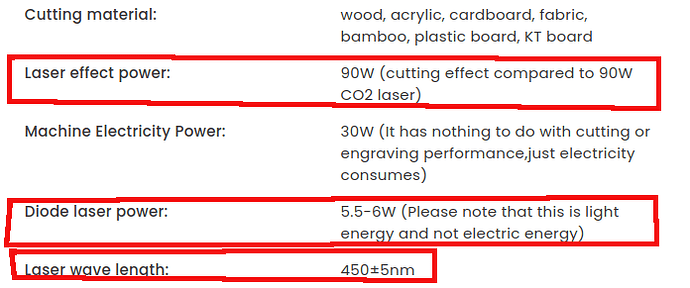Hi there from newby. A couple of days ago I became the happy owner of my first laser engraver Sculpfun S9. First hours I did some test engraving with glasses, then I (probably was too stupid) and next few days used it without any glasses. Today I read how dangerous is laser even if you don’t put it directly in eyes and understood how stupid I was.
Later I found that on official S9 description such information " Circle eye protection cover design: The laser filter cover filters 98% of the ultraviolet light to the eyes. You and the people around you can watch laser engraving from all angles without wearing goggles. At the same time, it can prevent animals from catching the laser spot." SCULPFUN S9 | Laser Module 5.5W| Laser Head – sculpfun
Now I wonder if it is official information does it really mean that it is safe enough to use it without any glasses? In such a case why does Sculpfun themself give googles together with the engraver kit?
Bit confused…
I personally wouldn’t trust a laser manufacturer with the only pair of eyes I have. The fact that they can build this doesn’t make them experts in your health. I would wear the goggles, and consider the shield to be protection for someone (or a pet) who accidentally enters the room.


It’s good that there is at least some attempt at filtering out the UV — that’s better than nothing, I guess. I would say that their adding that filter is a responsible thing to do, but then encouraging people not to wear goggles while using it is unwise.
I do expect that the filter reduces the overall risk substantially. I would guess that you are OK! Just be aware: Eye damage from UV lasers is permanent, is to your retina (the beam passes through your lens), and is painless. Also, your brain is good at constructing plausible bits for anything that is missing. So it’s easily possible to be unaware of damage. Therefore, as far as I know, the only way to be sure is for an eye doctor to examine your retina. (But also as far as I know it also can’t heal.)
The level of risk probably depends a lot on what you are engraving. Wood is probably meaningfully lower risk than metal with a brushed or satin surface, for instance. And also if you are aligned so that the circular filter is between your eyes and where the beam hits the workplace, the chance of a specular reflection bouncing out, hitting something else flat and shiny, and then hitting your eyes, is probably quite low.
So considering the shield as part of a “swiss cheese model” for threat reduction, along with goggles, makes more sense to me than merely replacing goggles.
Does that help?
I just wonder also about the overall working approach. Currently engraver stay near my PC working place and when it works I sit nearly and do my other work on PC.
Working on PC all the time with green goggles? I don’t think it is a realistic scenario for me.
Meanwhile, splitting these two activities to leave the room and leaving the engraver machine to work alone is also not recommended due to safety reasons.
So is it really only a protective case/shield is the solution?
And one more dummy question. In engraver manual said that the laser is most effective when precisely focused (20mm from the source). Does it mean that on 1m distance for example and after reflection from sourface it’s unfocused and isn’t so dangerous anymore?
You are right that the beam spreads out, and as it spreads out it will get to the point where it won’t burn, say, wood, but it takes much less power to damage your eye than to engrave. And even as the beam spreads out, the light is still coherent. These are Class 4 lasers, for which:
Even staring at the diffuse reflection of a laser “dot” on a wall or other surface, may cause an eye injury within a few feet of the dot.
Coherent light is weird and our intuition about light doesn’t protect us.
The properties of coherence makes lasers hazardous even at very low powers. Some lasers operating at a power of just a few milliWatts (mW) or less can cause instantaneous damage to the eye and/or skin if exposed. Because laser light is monochromatic and coherent, the distances with which lasers can be hazardous are quite long; typically miles long.
…
Class 4: Unsafe for intrabeam viewing. All specular and diffuse [emphasis mine] reflections of Class 4 beams are hazardous. Class 4 laser powers can be high enough to transfer enough heat onto objects where fires can begin. Engineering and/or administrative controls must be in place to ensure to ensure that individuals operating the laser; and in the vicinity of the beam, are protected. Training is required for all operators of Class 4 lasers.
You are also right to not leave it alone while working. Especially for materials that can catch fire!
How much room is there between the shield and the work? What is your angle of view? The larger the gap the less effective the shield.
What materials are you engraving? I don’t expect that burning wood is going to reflect a meaningful amount of coherent light (though I’m open to correction). Metal with a satin surface might have a lot more unexpected reflections.
I very much understand the desire to multi-task. And ultimately the decision is yours. But if you want someone to say it is absolutely safe to do so, I at least am not going to be that person. ![]()
Someone else might tell you that it’s “probably OK” or “relatively save” and they might by some reasonable definition be right. Your chances might well be better than 50/50 of escaping eye damage with that shield in place; I don’t know. What percent chance of permanent eye damage is acceptable to you?
If I wanted to run a blue diode laser while working on a computer next to it, I would put it inside a plexiglass 2422 enclosure. It’s more expensive than plain plexiglass, but at least here in the US not tremendously more so, and to me it’s worth the cost to protect my eyes; they don’t make replacements for those… I also would use air assist to reduce risk of flame and keep the lens cleaner, and keep a CO2 fire extinguisher handy.
There are numerous instances where hobby laser machines are shipping with no safety measures. As a result, users think that they must be safe. You will notice that none of these machines have formal safety approval. It does not take very much laser power to damage your retina. The damage is not repairable!
Although I do not discourage the use of glasses they are in no means an acceptable single means of protecting damage to your eyes.
Accidents happen. By definition, this means that something unexpected occurred.
Machine safety systems are employed to ensure the safety of the operator independent of their actions or apparel. As a minimum safety provisions should control the machine’s behavior independent of the state of the operator.
Examples:
-
The laser was on unexpectedly when you were not wearing goggles. You did not even realize the machine was powered. You are exposed!
-
As a bystander, you did not realize a laser was on and a reflection exited the imaging area directly into your unprotected eyes.
Rationalizing how an accident happened is not compensation for vision loss.
There is one reasonably easy and convenient way to protect your eyes from an accident. The laser system should be covered so laser light cannot escape. Those covers should include an interlock that disables the laser drive from operating if the cover(s) are not properly closed.
BTW even interlocks can fail so this minimal protection is not perfect. Google the standards for laser safety to get a full treatment for how lasers are made safe by design.
I would never operate or be in a room with a laser device that did not at least have covers and interlocks.
Thank you guys for deep answer!
I thought the S9 was a visible light laser, not UV …?
![]()
I think that was my mistake, not @ms0000’s. I later said “blue diode” but for some reason in my initial response was thinking UV for reasons that I’m not clear on. ![]()
I sent to the site and copied their statement
New eye protection design: The laser filter cover filters 98% of the ultraviolet light to the eyes.
This is also on the site under technical
I guess, I have doubts about some of these claims.
![]()
Thanks for pointing out where I got “UV” from! I was feeling quite foolish.
But if the manufacturer themselves can’t tell whether they are selling a blue or UV laser, I’d say how much would anyone want to trust their claims that this shield makes it safe without any other eye protection?
It made me wonder also…
![]()
I’ve certainly been guilty of calling these ‘near-UV’ in the past.
But I just spent a pleasant 10 mins reading the Wikipedia UV article, and if it’s not below 400nm wavelength it’s not UV. So I’ll stop ![]()
